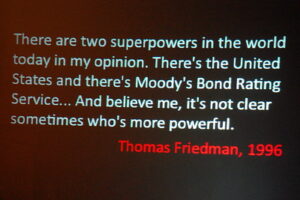I ran across an interesting item recently on why going to college has become so expensive. Fundamentally, there are many contributors to the cost of a college education. The annual price tag includes everything from operations to instruction and more.
For students attending public institution, the public subsidy is something in the neighborhood of 50%-60%. (That’s based on the comparison of student costs for public and private institutions.) So, why has the average cost of a public college education increased by 237% over the past 30 years? (Inflation, by the way, does not explain that. The cumulative rate of inflation over than time was 120%.)
According to the item, four of the main factors in the rise of the cost of a college education include:
(I swear – I didn’t write the piece.)
Marketing and the cost of a college education
It’s funny that the cost of marketing should top the list of budget-blowers. (Not funny – ha ha but funny – odd.) In June, the WCC Board of Trustees approved a $230,000 contract to pay for marketing services for WCC.
It’s funny for two reasons: first, in 2015, WCC budgeted $2.79M for Public Relations Development. That was 2.9% of WCC’s budget that year. In 2022, WCC budgeted $2.93M for Public Relations Development, which was 2.6% of the budget. Accounting for inflation in 2022 dollars, the WCC Public Relations Development budget, which includes Marketing, decreased by 16%.
To be fair, COVID-19 and its after-effects have impacted WCC’s budget. In real (2022) dollars. WCC’s budget is about 9.1% smaller today than it was in 2015, after accounting for inflation. So, inflation doesn’t fully account for the decrease in WCC’s marketing budget.
The other reason it’s funny, is that in the same meeting, the WCC Trustees approved a contract for $469,000 to repave the service drive.
I’m not making any judgments about the value of repairing the service drive, but rather, the Administration is willing to spend twice as much to repave the service drive as it is to recruit more students. In the grand scheme of things, a new service drive isn’t going to attract more students. (Not sure that additional marketing is going to attract more students either, but that’s a different discussion altogether.)
What probably would attract more students is new programs and investments in instruction. In 2015, WCC budgeted $54.5M for instruction. In 2022, the WCC instructional budget was $59.6M. When accounting for inflation, that represents a more than 12% decrease in spending on instruction over the course of eight fiscal years.
A budget is a statement of priorities
A budget is not just a plan for spending money. It identifies the institution’s priorities. When a community college goes to the public to ask for more money for operations, then decreases spending on instruction by nearly 15%, it is clear that attracting and retaining students is not the priority of this particular administration. When a community college administration cuts the budget for instruction, there had better be an exceedingly good reason for that. So far, I have not found one, and no one on the Board seems to have noticed.
I’ll look at construction costs as they relate to the cost of college education tomorrow.
Photo Credit: Daniel R. Blume, via Flickr


































